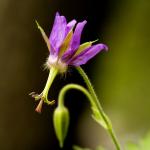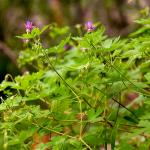Geranium dodecatheoides (Shootingstar Geranium)
Family
GERANIACEAE
Synonyms
NONE
Common Name
Shootingstar Geranium
| USFWS | State of NM | USFS | BLM | Navajo Nation | State Rank | Global Rank | R-E-D Code | NMRPTC Status | Strategy Status |
|---|---|---|---|---|---|---|---|---|---|
| SEN | S2 | G2 | 3-3-3 | R | SS |
| Overall Conservation Status | Documented Threats | Actions Needed |
|---|---|---|
| WEAKLY CONSERVED | No information |
Status surveys on abundance, distribution and threats |
Description
Erect, herbaceous perennial, 40-100 cm tall, glandular and eglandular hairs throughout; basal leaves in a more or less persistent rosette, palmately 5-parted, blade 3.7-4.4 cm long, 4.8-5.6 cm wide; stem leaves opposite, stipulate, 3-5-parted, the segments incised, toothed, or lobed; inflorescence a forking cyme; cymules 2-flowered, solitary; peduncles 2.7-4.6 cm long; pedicels 4.1-5.9 cm long; peduncle and pedicel together overtopping the subtending leaves; flowers pendulous; sepals and petals reflexed; petals purplish, 11.9-13.8 mm long, 2.8-4.7 mm wide, hairy on the basal quarter of the adaxial surface; stamens 10, all bearing anthers; filaments 10.9-12.8 mm long, straight, appressed to the stigmatic column; fruits erect, 3.0-3.6 cm long, elastically dehiscent, the mericarps remaining attached to the columella. Flowers July through September.
Similar Species
Geranium richardsonii and G. caespitosum are both vegetatively similar, but G. richardsonii has whitish flowers with spreading petals 12-20 mm long and G. caespitosum has purplish flowers with spreading petals that are broader than those of G. dodecatheoides and hairy halfway up the adaxial surface.
Distribution
New Mexico: Lincoln County. Three Rivers Canyon on the western slope of Sierra Blanca and east of Capitan Gap in the Capitan Mountains.
Habitat
Primarily among andesitic boulders and outcrops near the edge of canyon-bottom riparian forest; 2,300-3,000 m (7,550-9,900 ft).
Remarks
This is the only geranium in North America with reflexed petals although seven species in Europe and Asia have this feature. It was discovered in 2010 by Patrick Alexander while hiking the Three Rivers Trail (Tr. 44) on the Lincoln National Forest.
Conservation Considerations
This species is presently known from two localities in the Lincoln National Forest. The very small size of the known populations make it vulnerable to stochastic extinction events. Additional searches are needed.
Important Literature
*Aedo, C. and P.J. Alexander. 2011. Geranium dodecatheoides, a new species from New Mexico, U.S.A. Rhodora 113:252-259.
Information Compiled By
Charlie McDonald 2012. Last update 2014.
For distribution maps and more information, visit Natural Heritage New Mexico










